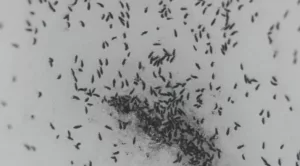Conservation Corner
Conservation Corner is a weekly article produced by the Forest County
Land &Water Conservation Department. For more information contact Steve Kircher, County Conservationist-Land Information/GIS Director at 715-478-1387 or by e-mail at .
With the recent snows, I began noticing little black spots in my tracks. Upon closer examination, I saw that most of these black spots were moving. With further research, I learned that these black spots are commonly known as “snow fleas”. They are not true fleas, but belong to a primitive group of insects known as springtails in the order Collembola. Springtails are among the most abundant of all soil-dwelling arthropods.
Uniquely adapted to survival in cold temperatures, they are able to synthetize an anti-freeze like protein that allows them to function in sub-zero temperatures. During the rest of the year, these creatures simply blend in amongst fallen leaves where they scavenge upon decaying materials and help with nutrient recycling.
Their flea-like common name is derived from their ability jump using a spring-like appendage called a furcula to propel themselves into the air.
Snow fleas do not bite and are harmless to humans and wildlife. They feed on decaying plant material and bacteria in the soil. Although present throughout the year, they are most likely to be noticed when they are crawling about on white snow.
Once the snow flea senses things are beginning to thaw, it moves from its mud-bound home to feed on algae and fungi in snow. If you have a compost pile in your background, chances are you’ve seen them.
They have no interest in humans. They have no interest in your pets. They may prefer things really, really dead.
They are very much important in our ecosystem to distribute the nutrients … and they can help to keep the microbes’ populations in check.
Snow fleas along with a myriad of other minute soil insects, fungi and microbes are an important component of healthy soil. Unseen but vital; Dr. Andrew Moldenke a researcher at Oregon State University once noted “Every time you take a step in a mature Oregon forest, your foot is being supported on the backs of 16,000 invertebrates held up by an average of 120,000 legs.” It is much the same here in northern Wisconsin.
Occasionally, in dry weather periods, snow fleas may migrate into homes and other outbuildings. Although they don’t pose any threat to the structures or inhabitants, their presence may be cause for concern.
These creatures are truly a winter curiosity if you haven’t encountered them before. The next time you’re out snowshoeing or cross-country skiing, keep an eye out for these tiny acrobats on the snow.


